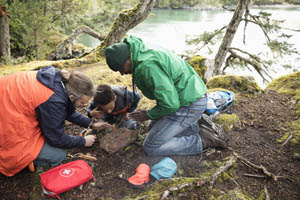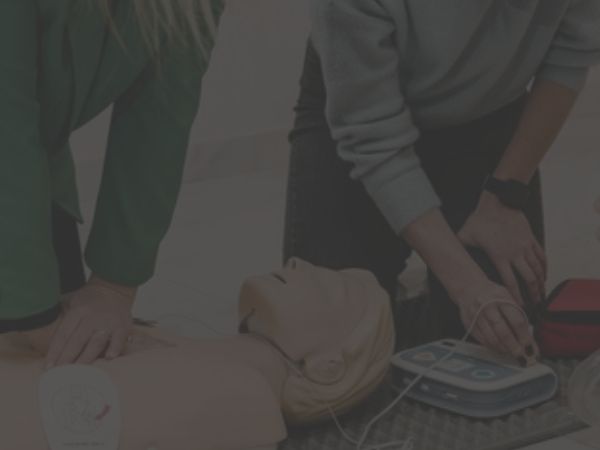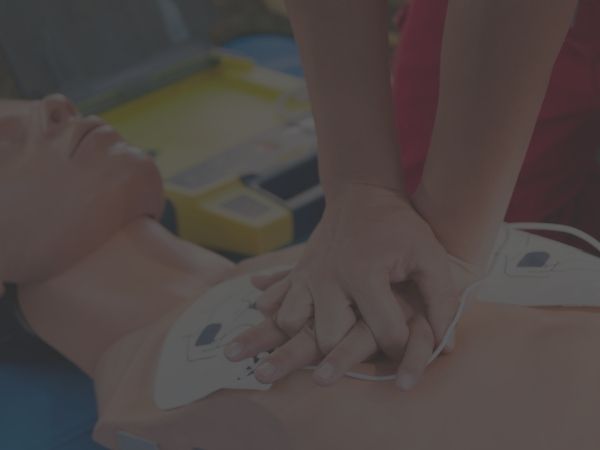Your cart is currently empty!
Do I Really Need a First Aid Kit and Certificate?
No one wants to think about the risk of accidents, but they happen. People may choke. Cars may collide. A day at the park may turn into a life-threatening reaction from insect venom. The risks are endless, and those with non-licensed employment, such as certified nursing assistants (CNAs), patient care assistants (PCAs) and even dietary aids, could be in the right place at the right time. Of course, common injuries range from minor cuts to loss of consciousness.
Depending on each person’s unique health history, any physical trauma, says NIGMS.NIH.Gov, could devolve into cardiac arrest or even shock. Fortunately, life-saving skills, including CPR and BLS, can make a difference. In addition, obtaining a First Aid Certification and knowing how to use the supplies in a First Aid kit will further prevent the worsening of symptoms and health in such situations, giving those that respond before emergency medical services arrive the tools needed to save lives. Therefore, those interested in a health care career must understand a few things about First Aid and how it opens the doors to career advancement.
What Is First Aid
 First Aid refers to the life-saving skills needed to respond to emergencies outside of a health care facility and such care that does not rise to the same level as emergency medical services (EMS). Various incidents may warrant First Aid, explains MedlinePlus. These include incidents where a person enters cardiac arrest or otherwise suffers from an unintentional injury. In addition, rendering First Aid provides the first-line support to those that need help.
First Aid refers to the life-saving skills needed to respond to emergencies outside of a health care facility and such care that does not rise to the same level as emergency medical services (EMS). Various incidents may warrant First Aid, explains MedlinePlus. These include incidents where a person enters cardiac arrest or otherwise suffers from an unintentional injury. In addition, rendering First Aid provides the first-line support to those that need help.
According to CPR.Heart.Org, a study found 55 percent of people cannot obtain First Aid training from their employers, and if such training is available, it often focuses on either CPR or First Aid, not both.
Falls are another type of injury that may require First Aid. As explained by the Centers for Disease Control and Prevention (CDC), as many as 20 percent of older adult falls—those over age 65—result in broken bones or head injuries. In addition, fall mortality rates skyrocketed 30 percent between 2007 and 2016. Part of the increase in mortality derives from a failure to obtain timely medical assistance, and if even one person had First Aid in the area, this statistic may not have been so stark.
Water-related incidents, including both recreational accidents and those deriving from flooding may warrant First Aid, and while drowning remains the fifth leading cause of injury, says the CDC, knowing how to respond is essential to saving lives. This may be in the form of CPR and treatment for injuries incurred. One of the most prominent risks for this time of year include animal attacks, including those of marine life, and reactions to insect bites.
Commercial First Aid kits are available and often include instructions on how to respond to common injuries, using the supplies. However, a trauma is the worst possible time to learn how to respond. For severe injuries, time lost could mean blood lost, if not increased risk of mortality.
According to the National Library of Medicine, receiving First Aid directly increases chances of survival following a trauma. In fact, mortality rates declined from 15.6 percent to 9.8 percent in a 2010 study of trauma victims in Iraq. Unfortunately, few studies have been conducted on the mortality reductions of First Aid in the U.S. However, a cohesive review of injury data and mortality risks indicates faster responsiveness is associated with an increased survival chance.
Why Is a First Aid Kit Required by OSHA
Misconceptions still exist with respect to mandated First Aid kits within U.S. workplaces. The Occupational Safety and Health Administration is responsible for enforcing compliance with First Aid standards for having a kit on-site. The disagreement derives from the interpretation that exists within whether a workplace needs a First Aid kit or not. The same issue exists in terms of First Aid training. Depending on industry and according to OSHA, all employers with a reasonable risk of injury are required to maintain a First Aid kit and offer training in First Aid to employees.
For example, electric companies, shipyards, marine terminals, longshoring and construction companies must maintain a First Aid kit. However, only electric companies and construction are required to have all employees maintain a First Aid Certificate. Others must offer on-site medical services with trained health care professionals to maintain compliance. Of course, First Aid is a topic of public safety, so any facility that places consumer and worker safety at the top of its priorities will likely have kits available.
So, what goes into a First Aid kit? This depends on where the kit will be placed and what reasonable injuries may occur. The kit contents tend to contain the same supplies, including gauze, bandages, adhesive tape, a tourniquet, eye shields, syringes, mouth barriers, antiseptic towelettes, peroxide, alcohol and medications, explains the Mayo Clinic. The size of the content varies by its intended use. However, the uniqueness of each kit means contents vary by facility and intended use. For instance, a personal First Aid kit might be small, and those in commercial facilities will be larger. For those with severe allergies, the First Aid kit may also include an epinephrine auto-injector, but since it is a medication, such contents require a physician’s prescription.
Times Where a First Aid Kit Will Be Useful
The application of first responding care is useful across a variety of settings, well beyond the walls of the workplace. An incident may occur anywhere and at any time. However, areas where a heightened risk of injury, cardiac arrest or other accident may occur should always have a First Aid kit readily available. A few key places where First Aid may be necessary include:
- Sporting venues and practice areas
- Volunteer centers
- Child care centers
- Schools
- Public transportation vehicles
- Recreational venues
- Park visitor centers
- Water attractions, including public swimming pools
- Large retail centers, such as shopping malls
10 Ways First Aid Boosts Career Opportunities for Ancillary Staff
 Obtaining a First Aid Certificate offers additional advantages for those that wish to pursue a career in health care, particularly among ancillary staff. Ancillary staff include any staff member that does not have a formal education from an accredited health institution and serves in a supportive role under a nurse, registered dietician or other licensed professional. In fact, consider these 10 ways completion of First Aid training will increase career advancement opportunities.
Obtaining a First Aid Certificate offers additional advantages for those that wish to pursue a career in health care, particularly among ancillary staff. Ancillary staff include any staff member that does not have a formal education from an accredited health institution and serves in a supportive role under a nurse, registered dietician or other licensed professional. In fact, consider these 10 ways completion of First Aid training will increase career advancement opportunities.
1. First Aid Provides a Means of Learning How to Respond to Facility Emergencies
The biggest benefit of First Aid training goes back to knowing how to respond to emergencies. When reviewing applications for employment, managers will look for a person’s existing knowledge of health care best practices. In addition, trained individuals have the knowledge to respond when an emergency occurs within or outside of a given environment.
2. Training May Be Necessary for Specific Volunteer Opportunities
Depending on employer, First Aid training may be required before working in patient-care areas. While new hires may complete training after obtaining employment, having a First Aid Certificate in advance further increases the attractiveness of your application.
3. It Demonstrates a Willingness to Learn
Completion of skills and coursework that go beyond the current scope of practice demonstrates a willingness to learn. Supervisors will look for applicants with a commitment to their career and its continuing education.
4. A First Aid Certificate Recognizes Completion of an Accredited Program
Anyone can review a First Aid manual, but completion of an accredited program ensures acceptance by potential employers. Furthermore, formal training eliminates all uncertainty regarding the quality of training, and for some programs, such training may occur in conjunction with CPR and BLS certification. As a result, those with a First Aid Certificate for all three life-saving skills can respond to a wider variety of emergencies.
5. Multiple Facilities May Have Additional Criteria Regarding Certifications for Ancillary Staff
Ancillary staff may have limited, if any, formal training for employment within the health care industry. While many facilities hire those without certifications and on-site training, completion of on-site training may be necessary to fulfill key employment promises. In addition, completion may open the door to a higher employment wage, recognizing the value of certified individuals as an integral part of the workforce.
6. It Bridges Ancillary Care and Nursing Care Skills
Ancillary skills are invaluable, and the same applies to nursing skills. First Aid bridges the divide between the two, giving people a way to apply skills that go beyond ancillary care scope and save lives. In addition, ancillary staff may need to use the First Aid kit when a coworker or visitor suffers an emergency while in the workplace.
7. Completion of First Aid Training Increases the Attractiveness of School Applications
For those interested in pursuing a career in health care, including attending nursing school or other advanced educational programs, obtaining applicable certificates, including CPR and First Aid Certificate, will increase the attractiveness of the application. In addition, volunteer work and extracurricular activities enhance nursing school applications too, and participation in extracurricular activities will benefit from those with a CPR and First Aid Certification.
8. It Empowers Individuals With Confidence
Obtaining your certificate to render First Aid offers much more than just skills. It builds on self-confidence and empowers individuals with the knowledge to respond without fear. In an emergency, fear can lead to disastrous outcomes, so boosting self-confidence will effectively save lives.
9. Knowing First Aid Reduces Mortality
First Aid reduces mortality, and while you may never know the person saved outside of the workplace, think about what it means for your future. The person saved could be a friend, family member, instructor or coworker. This list goes on, and if you can reduce that person’s mortality, it will have a resounding, positive effect on your life, as well as his or hers.
10. It Encourages Critical Thinking Skills
Finally, completion of additional training programs builds critical thinking skills. A person suffering from trauma may exhibit multiple medical needs, ranging from wound care to cardiac arrest. Those with the skills to respond must evaluate the scene, assess the person, address the most life-threatening needs first, contact EMS, work with other passersby and manage everything without hesitation. This builds strong critical thinking skills, which are applicable in every health care industry and career.
Empower Your Career With a First Aid Kit and Certification for CNAs and PCAs
The most enjoyable event or mundane task can turn into tragedy when an accident occurs. They may be intentional or unintentional, and without immediate treatment, mortality risk increases. In the health care profession, nurses have the duty to respond when such events occur. However, the value does not end with nurses. CNAs, PCAs and other supportive staff can provide immediate care after obtaining a First Aid Certificate and know how to use a First Aid kit.
Of course, the exact requirements and limitations of such care vary by employer. Even aside from applying First Aid while at work, those that complete training are more prepared to respond in everyday situations, away from the safety of the workplace. Know how First Aid impacts lives. Know how it can be a useful tool in reducing mortality. It begins with taking the steps to enroll in a program.
Gain the skills to respond when an emergency arises; remember to build your First Aid kit too. Finally, enroll in your first-responder skills course to prepare for a health care future and maximize your responsiveness. Have you ever been in a situation where someone required First Aid? If so, share your experiences along with this article to social media now. Together, we can save lives through knowledge and preparedness.
Keep Reading
2 responses
Hi Chris,
I really appreciate your insight share here, thank you for taking the time to provide your feedback!










I had no idea that you can make your school applications more attractive by being certified in First Aid. This is an awesome incentive to get people to learn First Aid. It never hurts to know how to save another person’s life.